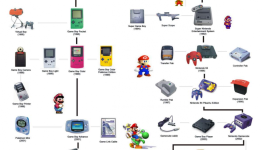The History of Nintendo: From Playing Cards to Video Game Giant
Nintendo, a company that has become synonymous with gaming, has a rich and diverse history. Founded in 1889, Nintendo has survived and thrived through various economic and technological eras. This article will explore the origins of Nintendo, its foray into the world of video games, and the impact it has had on the industry.
Early Beginnings: Hanafuda Cards and Beyond
Nintendo was founded by Fusajiro Yamauchi on September 23, 1889, in Kyoto, Japan. The company initially produced handmade Hanafuda cards, a type of Japanese playing card used for a variety of games. Nintendo's Hanafuda cards gained popularity, leading Yamauchi to expand the business.
In 1929, Yamauchi retired and handed over the company to his son-in-law, Sekiryo Kaneda, who later took the Yamauchi family name. Under Kaneda's leadership, the company continued to manufacture playing cards and expanded into other ventures, including a taxi service and a love hotel. However, these ventures were not successful.
In the early 1960s, Hiroshi Yamauchi, the grandson of Fusajiro Yamauchi, became president of Nintendo. He shifted the company's focus and entered the toy market with the Ultra Hand, a plastic extending arm. The Ultra Hand was a success, selling over a million units and solidifying Nintendo's entry into the toy industry.
The Dawn of Video Games: Color TV-Game and Game & Watch
In the mid-1970s, Nintendo entered the fast-growing video game market with the Color TV-Game series, which were dedicated home video game consoles featuring simple built-in games. These consoles were modestly successful in Japan but never reached a global audience.
In 1980, Nintendo released the Game & Watch series, portable electronic games with LCD screens that doubled as digital clocks. The Game & Watch series was designed by Gunpei Yokoi, who would later be a key figure in the development of the Game Boy. The Game & Watch series was a success, selling millions of units worldwide.
The Nintendo Entertainment System and the Golden Age of Console Gaming
In 1983, Nintendo released the Family Computer (Famicom) in Japan, a home video game console that used interchangeable cartridges. The console was a massive success in Japan, and Nintendo decided to bring it to the North American market. In 1985, the Nintendo Entertainment System (NES) was released in the United States, along with the now-iconic game "Super Mario Bros." The NES was a massive success, revitalizing the video game industry after the infamous crash of 1983.
Nintendo continued its success with the release of the Game Boy in 1989, a portable cartridge-based console. The Game Boy, designed by Gunpei Yokoi, became an instant phenomenon, selling millions of units worldwide. The release of "Tetris" for the Game Boy solidified its popularity and established Nintendo as the dominant force in portable gaming.
The Super Nintendo and the Console Wars
In 1990, Nintendo released the Super Famicom in Japan, followed by the Super Nintendo Entertainment System (SNES) in North America in 1991. The SNES boasted improved graphics and sound capabilities compared to the NES and featured iconic games such as "The Legend of Zelda: A Link to the Past," "Super Mario World," and "Donkey Kong Country."
The SNES faced stiff competition from Sega's Genesis console, leading to the intense "console wars" of the 1990s. Despite the rivalry, the SNES ultimately outsold the Genesis and further solidified Nintendo's place in the video game industry.
The Nintendo 64, GameCube, and Wii
Nintendo continued its success with the release of the Nintendo 64 in 1996, which featured 3D graphics and innovative games such as "Super Mario 64" and "The Legend of Zelda: Ocarina of Time." The Nintendo 64 faced competition from the Sony PlayStation and the Sega Saturn but was successful due to its strong lineup of games.
In 2001, Nintendo released the GameCube, which was a departure from the cartridge-based systems of the past. The GameCube utilized mini DVDs for game storage and had a unique controller design. Notable games for the GameCube include "Super Smash Bros. Melee," "The Legend of Zelda: The Wind Waker," and "Metroid Prime."
In 2006, Nintendo released the Wii, a home console that introduced motion controls and a more casual gaming experience. The Wii was a massive success, selling over 100 million units worldwide and popularizing games like "Wii Sports" and "Mario Kart Wii."
The Nintendo Switch and Beyond
In 2017, Nintendo released the Nintendo Switch, a hybrid console that can be used as a home console and a portable device. The Switch has been a major success, with popular games such as "The Legend of Zelda"




.jpeg)
